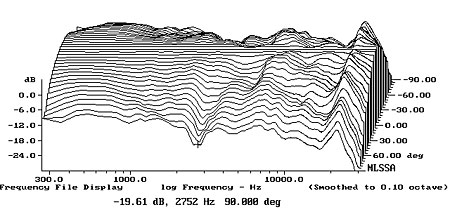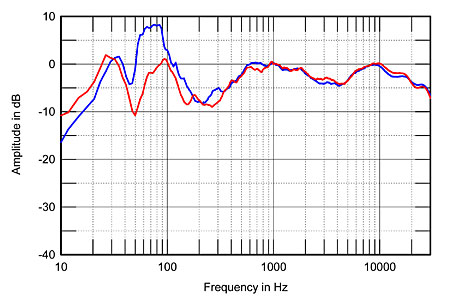| Columns Retired Columns & Blogs |
Verity Audio Sarastro II loudspeaker Measurements
Sidebar 3: Measurements
As Fred Kaplan explains, the primary difference between the Sarastro II and the original Sarastro (reviewed by Michael Fremer in March 2005), is the upgraded tweeter and associated changes to the crossover. In many respects, the new loudspeaker measured very similarly to the earlier version—you can find my measurements of the Sarastro I here.
My B-weighted estimate of the Verity's voltage sensitivity on its tweeter axis was identical to that of the Mk.I, at 92.5dB(B)/2.83V/m, which is usefully higher than average. Its impedance (fig.1) is also very similar to that of the original Sarastro, staying above 6 ohms for much of the audioband. The minimum value is 3 ohms at 8kHz, though the electrical phase angle is not quite as severe in the mid-treble as the Mk.I's.

Fig.1 Verity Sarastro II, electrical impedance (solid) and phase (dashed). (2 ohms/vertical div.)
The vibrational behavior of the two enclosures was also similar to the original speaker's. The back panel of the head unit was the liveliest, with fairly strong modes at 430Hz and 512Hz, but as this panel faces away from the listener, the audible effect should be minimal. The front panel of the bass unit had a low-level mode apparent at 310Hz. FK didn't comment on any midrange congestion that might have resulted from this behavior.
Fig.2 shows the responses of the midrange unit (black trace), head-unit port (blue), woofer (red), and bass-unit port (green). The midrange unit has a minimum-motion notch in its output at 54Hz; the head-unit's port actually peaks higher in frequency, in the region where the midrange unit also peaks before starting its rolloff. As with the original Sarastro, the series capacitor in the midrange unit's crossover upsets the driver's reflex tuning. I wonder if this behavior correlates with the "ripeness" FK noted. Certainly, playing the half-step–spaced toneburst track on my Editor's Choice CD (Stereophile STPH016-2), I could hear some lower-frequency spuriae between 80Hz and 200Hz, though it is fair to note that this signal is very much the worst case for revealing problems like this. The minimum-motion notch in the woofer's output occurs at 27Hz (the center frequency of the saddle in the impedance magnitude trace), with the port's output broadly peaking in the same region. This is a speaker potentially offering extension almost to 20Hz. The port's higher-frequency output, however, has resonant modes apparent at 290Hz and 410Hz, though the fact that this port faces away from the listener will minimize their audibility.

Fig.2 Verity Sarastro II, nearfield responses of midrange unit (black), head-unit port (blue), woofer (red), and bass-unit port (green), scaled in the ratio of the radiating diameters.
The left-hand side of fig.3 shows how these nearfield responses sum at a nominal farfield measuring point. The coincidence of the peaks in the midrange unit's and head-unit port's outputs results in an excess of mid-bass. Some of this excess will be due to the nearfield measurement technique, but not all of it. This, again, will contribute to the "ripeness" in the Sarastro II's lower-frequency character. Assessing the lower-midrange behavior of a speaker like this, with multiple radiators active in the same region, is problematic. Even so, it does appear that like its predecessor, the Mk.II Sarastro has suboptimal integration between its midrange and woofer. Higher in frequency, there is the same broad hump at the top of the midrange followed by the same broad depression in the presence region. But the newer ribbon has a somewhat suppressed top octave on-axis compared with the first version.

Fig.3 Verity Sarastro II, anechoic response on tweeter axis at 50", averaged across 30° horizontal window and corrected for microphone response, with the complex sum of the nearfield midrange, woofer, and ports responses plotted below 300Hz.
It is commendable for Verity's design team to use one unit to cover almost the entire range of musical fundamentals, but that means using a drive-unit with a radiating diameter a little too large for optimal treble dispersion. The 6" unit used in the Sarastro becomes quite directional above 2kHz. The Sarastro II's horizontal dispersion (fig.4) lacks energy, therefore, at the top of the midrange unit's passband. On the other hand, the ribbon tweeter puts out more energy to its sides above 20kHz than it does on-axis. In the vertical plane (fig.5), a suckout appears at 4.4kHz for listening axes even slightly above the center of the tweeter, which is a high 42" from the floor. A less-severe suckout appears 10° below the tweeter, implying that the optimal vertical listening widow is quite narrow.

Fig.4 Verity Sarastro II, lateral response family at 50", normalized to response on tweeter axis, from back to front: differences in response 90–5° off axis, reference response, differences in response 5–90° off axis.

Fig.5 Verity Sarastro II, vertical response family at 50", normalized to response on tweeter axis, from back to front: differences in response 15–5° above axis, reference response, differences in response 5–15° below axis.
I performed a spatially averaged in-room response in both Fred Kaplan's listening room and in my own room. Using Fuzzmeasure 2.0 from SMUG Software running on my Macintosh Powerbook in conjunction with a FireWire audio interface from Metric Halo and an Earthworks QTC-40 omnidirectional microphone, I measured the responses of the left and right speakers taken individually in a vertical rectangular grid 36" wide by 18" high, centered on the position of the listener's ears in his listening chair, and in both rooms the speakers toed-in to the listening seat. Fig.6 shows the average of these responses in Fred's room (blue trace) and in my room (red). Despite the very different sizes and furnishings of our rooms, the traces overlap to an extraordinary degree above 300Hz, perhaps because we both sit approximately the same distance from the speakers (110" in my case, 114" in Fred's). The midrange unit's increased directionality in the presence region does lead to a lack of in-room energy in the same region, which leaves the high treble a little exposed. (I heard a slight exaggeration of the analog tape hiss resulting from this balance.)
There is also insufficient lower-midrange energy in-room, but the primary difference between the two traces in fig.6 lies in the bass. As FK conjectured, the dimensions of his room accentuate the mid-bass, and unfortunately, this coincides with the region where all four of the Sarastro II's low-frequency radiators are active. The result is a considerable exaggeration of the mid-bass (blue trace), which FK described as "a bit of a boom, at around 100Hz," though he did add that this boom didn't obscure detail. In my room (red trace), the balance is more even through the bass region, with my more solid wall construction giving a little more reinforcement in the bottom octave. But the relative lack of energy between 40Hz and 60Hz in my room, a consistent feature of my room's acoustics as can be seen from the in-room measurements I have published of other speakers, left the low bass sounding a little disconnected.

Fig.6 Verity Sarastro II, spatially averaged, 1/6-octave response in FK's listening room (blue) and in JA's listening room (red).
In the time domain, the Sarastro's step response in the tweeter axis (fig.7) indicates that the tweeter and midrange unit are both connected with the same positive acoustic polarity. The overshoot of the tweeter's step is smoothly integrated with that of the midrange unit, suggesting that the upper crossover is well-organized. The woofer, too, is connected with positive polarity, and contributes to the rise above the timeline to the right of the 6ms mark in this graph. The Mk.II Sarastro's cumulative spectral decay plot on the tweeter axis (fig.8) is significantly cleaner than that of the original in the region covered by the new Verity tweeter. There is no sign of the ridge of delayed energy at 6.7kHz that affected the earlier version—this is indeed a better-performing ribbon unit.

Fig.7 Verity Sarastro II, step response on tweeter axis at 50" (5ms time window, 30kHz bandwidth).

Fig.8 Verity Sarastro II, cumulative spectral-decay plot on tweeter axis at 50" (0.15ms risetime).
I note that Fred Kaplan very much liked the sound of the Sarastro IIs in his room, and I, too, enjoyed much of what I heard when the speakers resided in my listening room. But it does have an identifiable character that stems both from the decision to take the fairly large midrange unit up so high in frequency before crossing over to the ribbon unit and from the complex overlap between the midrange unit, the woofer, and their respective ports. As I summed up my thoughts of the original Sarastro, the speaker's "idiosyncratic measured performance suggests. . . that the designer carefully arrived at the speaker's balance by listening rather than go for a clean measured performance and then fine-tune the speaker by ear." Nothing about the Sarastro II's measured performance has changed my mind. This Verity has much to offer but prospective owners are advised to audition the Sarastro in their own home if at all possible to see if its positive attributes out-shadow the idiosyncrasies.—John Atkinson
- Log in or register to post comments




































